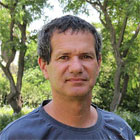Yoav Gothilf, PhD, Tel Aviv University

Yoav Gothilf, PhD
The Gothilf Laboratory utilizes the zebrafish model and cutting edge technologies to focus on several aspects of the circadian clock: The function, development, synchronization, localization, and importance of the circadian clock system in the life of the organism.
All organisms demonstrate a wide variety of behavioral and physiological daily rhythms that are driven by an evolutionary conserved endogenous circadian clock mechanism. Maintenance of circadian rhythms is crucial for the physical and mental wellbeing, and disruption of the rhythms increases susceptibility to diseases and psychiatric disorders.
Products
References
- Tovin A, Alon S, Ben-Moshe Z, Mracek P, Vatine G, Foulkes N, Jacob-Hirsch J, Rechavi G, Toyama R, Coon SL, Klein DC, Eisenberg E, Gothilf Y (2012). Systematic identification of rhythmic genes reveals camk1gb as a new element in the circadian clockwork. PLoS Genet. 8(12): e1003116.
- Smadja-Storz S, Tovin A, Mracek P, Alon S, Foulkes N, Gothilf Y (2013) Casein kinase 1delta activity: a key element in the zebrafish circadian timing system. PLoS One. 8(1):e54189.
- Daya A, Vatine GD, Becker-Cohen M, Tal-Goldberg T, Gothilf Y, Du S-J, Stella Mitrani-Rosenbaum S (2014) Gne depletion during zebrafish development impairs skeletal muscle structure and function. Human Molecular Genetics. 23(13):3349-3361.
- Ben-Moshe Z, Alon S, Mracek P, Faigenbloom L, Tovin A, Vatine G, Eisenberg E, Foulkes SN, Gothilf Y (2014). The light-induced transcriptome of the zebrafish pineal gland reveals complex regulation of the circadian clockwork by light. Nucleic Acids Research. 42(6): 3750-3767.



